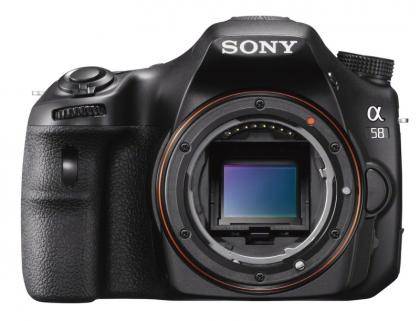The vast majority of SLRs we see on the street bear Canon or Nikon logos. Sony clearly wants to change this, and by our reckoning it's going about it the right way. Digital SLR technology is mature and refined, and ultimately there's little to choose between similarly priced Canon and Nikon models. Sony, on the other hand, provides some genuine choice with cameras such as the new Sony SLT-A58.

The new camera isn't a straight replacement for either the A57 or A37
Its SLT cameras aren't technically SLRs. They use a translucent, non-moving mirror that passes light simultaneously to the main sensor and the autofocus sensor. This has various repercussions, but it allows for fast continuous shooting with full-time autofocus, plus it delivers responsive autofocus while recording video.
FINDING A VIEW
Its viewfinder is electronic rather than optical, which won't please purists, but an electronic viewfinder (EVF) has its advantages. It means the viewfinder can overlay lots of information, and it can also provide a preview of exposure and white balance settings. The large, high-resolution displays used in Sony SLTs are a million miles away from the poky EVFs found in most ultra-zoom cameras.

Sony's SLT technology continues to make a persuasive alternative
Perhaps the most significant difference for people upgrading from a compact camera is that the main autofocus system is available when composing shots on the LCD screen. With a true SLR, live view requires the camera to switch to a slower, secondary autofocus system.
The A58 replaces both the entry-level Sony SLT-A37 and its pricier sibling, the A57. It's not the straightforward upgrade to the A57 that the name suggests, though.
The A57 had a 3in, 921,000-dot screen that could twist and pivot to face almost any direction. The A58's screen is smaller and coarser at 2.7in and 460,000 dots, and tilts up by 90 degrees and down by 45. Considering how well this camera's live view mode performs, it's an odd place to be cutting costs. At least this screen is sharper than the A37's 230,000-dot screen. Viewing angles could be better, with skewed colours when viewed from above, but the tilting design should mean that this isn't an issue in practice.
The previous models' viewfinders were LCDs but the new one is an OLED. This should give deeper contrast, although without comparing them side-by-side we can't say for sure. It has the same 1,440,000-dot resolution as before but it's physically smaller (with a 0.88x magnification, down from 1.09x on the A37 and 1.04x on the A57). A big viewfinder makes a huge difference, and this was a big selling point for previous SLT cameras. Still, the 0.88x magnification is on a par with the optical viewfinders in Canon and Nikon's SLRs at this price. Comparing the A58 with a Nikon D5200 at matching focal lengths, text was very slightly more legible through the D5200's viewfinder. However, focusing manually was easier on the A57, thanks to a 2x digital zoom function and a focus peaking display, which highlights sharply focused parts of the scene.
PIXELLATION
The 20-megapixel resolution is a significant jump from the 16-megapixel A37 and A57. We're happy to report that noise levels haven't increased as a result. If anything they're marginally lower than from the A37. Continuous performance has taken a hit, though. Full-resolution shooting is at 5fps, down from 10fps on the A57 and 5.5fps on the A37. It's still not a bad result, but no longer significantly better than the competition.

Composing on the screen is straightforward thanks to the translucent mirror inside
As with its predecessors, there's a speed-priority mode that manages faster performance – in this case 8fps – complete with continuous autofocus, but the image is cropped to a 5-megapixel central portion of the frame. It could be useful for capturing distant wildlife, but it's a big step down from the A57's 12fps, 8.4-megapixel mode.
The controls are virtually indistinguishable to the A57's, with just a couple of button locations swapped around. It's a good system, with dedicated buttons for many key functions, plus a Fn button that reveals a quick-access menu. We wish that JPEG and raw settings were accessible via the Fn button, but otherwise the controls are straightforward and effective.
Sony's proprietary hotshoe has been replaced by a design that virtually all other camera manufacturers use. In fact, it's actually yet another new proprietary design, called the Multi Interface Shoe, but because it's based on a standard design, it can accommodate generic accessories such as wireless flash triggers.






Leave a Reply